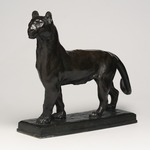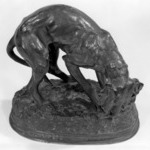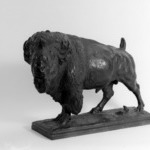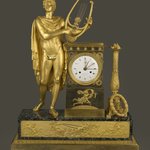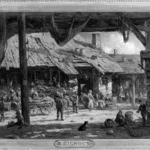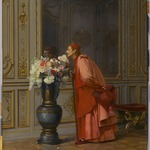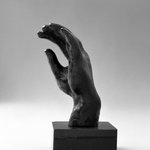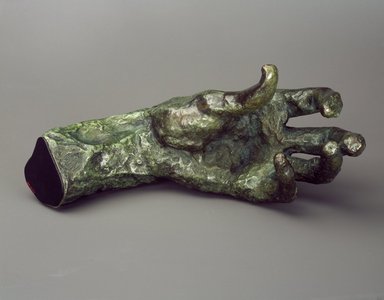
Large Left Hand (Grande main gauche)
Auguste Rodin
European Art
Rodin was fascinated by the expressive capabilities of partial figures and fragmented body parts, particularly hands. He modeled hundreds of them, using them both as parts of more complex pieces and as independent sculptures that did not require further context or connection to communicate meaning and emotion.
Inspired by Renaissance artists and the academic tradition, Rodin took anatomy classes and studied preserved body parts and anatomical models on view at a medical museum in Paris. The contorted shapes of the diseased hands he saw there may have inspired hand studies like this one. Indeed, some physicians who have studied his hand sculptures claim to be able to discern specific syndromes and injuries in them.
Inspired by Renaissance artists and the academic tradition, Rodin took anatomy classes and studied preserved body parts and anatomical models on view at a medical museum in Paris. The contorted shapes of the diseased hands he saw there may have inspired hand studies like this one. Indeed, some physicians who have studied his hand sculptures claim to be able to discern specific syndromes and injuries in them.
MEDIUM
Bronze
DATES
before 1912; date of cast unknown
DIMENSIONS
11 5/8 x 4 1/2 x 5 1/2 in. (29.5 x 11.4 x 14 cm) (show scale)



SIGNATURE
Inside of wrist: "RODIN"
COLLECTIONS
European Art
ACCESSION NUMBER
84.75.17
CREDIT LINE
Gift of the Iris and B. Gerald Cantor Foundation
EXHIBITIONS
MUSEUM LOCATION
This item is not on view
CAPTION
Auguste Rodin (French, 1840–1917). Large Left Hand (Grande main gauche), before 1912; date of cast unknown. Bronze, 11 5/8 x 4 1/2 x 5 1/2 in. (29.5 x 11.4 x 14 cm). Brooklyn Museum, Gift of the Iris and B. Gerald Cantor Foundation, 84.75.17. Creative Commons-BY (Photo: Brooklyn Museum, 84.75.17_SL3.jpg)
IMAGE
overall, 84.75.17_SL3.jpg. Brooklyn Museum photograph
"CUR" at the beginning of an image file name means that the image was created by a curatorial staff member. These study images may be digital point-and-shoot photographs, when we don\'t yet have high-quality studio photography, or they may be scans of older negatives, slides, or photographic prints, providing historical documentation of the object.
RIGHTS STATEMENT
Creative Commons-BY
You may download and use Brooklyn Museum images of this three-dimensional work in accordance with a Creative Commons license. Fair use, as understood under the United States Copyright Act, may also apply.
Please include caption information from this page and credit the Brooklyn Museum. If you need a high resolution file, please fill out our online application form (charges apply).
For further information about copyright, we recommend resources at the United States Library of Congress, Cornell University, Copyright and Cultural Institutions: Guidelines for U.S. Libraries, Archives, and Museums, and Copyright Watch.
For more information about the Museum's rights project, including how rights types are assigned, please see our blog posts on copyright.
If you have any information regarding this work and rights to it, please contact copyright@brooklynmuseum.org.
RECORD COMPLETENESS
Not every record you will find here is complete. More information is available for some works than for others, and some entries have been updated more recently. Records are frequently reviewed and revised, and we welcome any additional information you might have.





